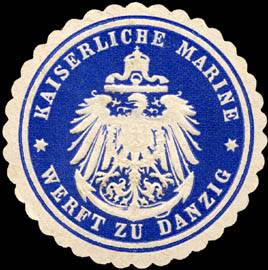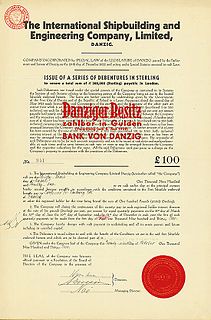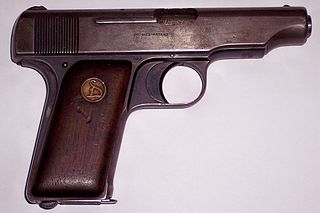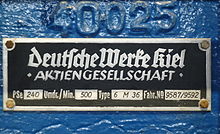
The Type II U-boat was designed by Nazi Germany as a coastal U-boat, modeled after the CV-707 submarine, which was designed by the Dutch dummy company NV Ingenieurskantoor voor Scheepsbouw Den Haag (I.v.S) and built in 1933 by the Finnish Crichton-Vulcan shipyard in Turku, Finland. It was too small to undertake sustained operations far away from the home support facilities. Its primary role was found to be in the training schools, preparing new German naval officers for command. It appeared in four sub-types.

Blohm+Voss (B+V), also written historically as Blohm & Voss, Blohm und Voß etc., is a German shipbuilding and engineering company. Founded in Hamburg in 1877 to specialise in steel-hulled ships, its most famous product was the World War II battleship Bismarck. In the 1930s, its owners established the Hamburger Flugzeugbau aircraft manufacturer which, shortly before the outbreak of World War II, adopted the name of its parent company. Following a difficult period after the war, B+V was revived, changing ownership among several owners, as Thyssen Group and Star Capital. In 2016, it became a subsidiary of Lürssen and continues to supply both the military and civilian markets. It serves two areas – new construction of warships as NVL B.V. & Co. KG, and new construction and refitting of megayachts. The company has been in operation, building ships and other large machinery, almost continuously for 145 years.

Aktien-Gesellschaft „Weser" was one of the major German shipbuilding companies, located at the Weser River in Bremen. Founded in 1872 it was finally closed in 1983. All together, A.G. „Weser" built about 1,400 ships of different types, including many warships. A.G. „Weser" was the leading company in the Deutsche Schiff- und Maschinenbau AG, a cooperation of eight German shipbuilding companies between 1926 and 1945.

Howaldtswerke-Deutsche Werft is a German shipbuilding company, headquartered in Kiel. It is part of the ThyssenKrupp Marine Systems (TKMS) group, owned by ThyssenKrupp. The Howaldtswerke shipyard was founded in Kiel in 1838 and merged with Hamburg-based Deutsche Werft to form Howaldtswerke-Deutsche Werft (HDW) in 1968. The company's shipyard was formerly used by Friedrich Krupp Germaniawerft until the end of World War II.
Maschinenbau Kiel GmbH designed, manufactured and marketed marine diesel engines, diesel locomotives and tracked vehicles under the MaK brand name. The three primary operating divisions of Maschinenbau Kiel GmbH were sold to different companies in the 1990s.

Bremer Vulkan AG was a prominent German shipbuilding company located at the Weser river in Bremen-Vegesack. It was founded in 1893 and closed in 1997 because of financial problems and mismanagement.
Friedrich Krupp Germaniawerft was a German shipbuilding company, located in the harbour at Kiel, and one of the largest and most important builders of U-boats for the Kaiserliche Marine in World War I and the Kriegsmarine in World War II. The original company was founded in 1867 but went bankrupt and was bought out by Friedrich Krupp. Krupp was very interested in building warships and in the time before the First World War built a number of battleships for the Kaiserliche Marine, including SMS Posen, SMS Prinzregent Luitpold, SMS Kronprinz, and SMS Sachsen. A total of 84 U-boats were built in the shipyard during the war. After the war it returned to the normal production of yachts and transports.

Deutsche Schiff- und Maschinenbau Aktiengesellschaft was a cooperation of eight German shipyards in the period 1926 to 1945. The leading company was the shipyard AG Weser in Bremen.
German submarine U-353 was a Type VIIC U-boat of Nazi Germany's Kriegsmarine during World War II. The submarine was laid down on 30 March 1940 at the Flensburger Schiffbau-Gesellschaft yard at Flensburg, launched on 11 November 1941, and commissioned on 31 March 1942 under the command of Oberleutnant zur See Wolfgang Römer. After training with the 5th U-boat Flotilla based at Kiel, U-353 was transferred to the 1st U-boat Flotilla at Brest in France for front-line service from 1 October 1942.
NV Ingenieurskantoor voor Scheepsbouw, usually contracted to IvS, was a Dutch dummy company set up in The Hague and funded by the Reichsmarine after World War I in order to maintain and develop German submarine know-how and to circumvent the limitations set by the Treaty of Versailles. The company designed several submarine types for paying countries, including the Soviet S-class submarine, as well as the prototypes for the German Type II submarines and Type VII submarines.

Kaiserliche Werft Danzig was a German shipbuilding company founded in 1852 as Königliche Werft Danzig and renamed Kaiserliche Werft after the proclamation of the German Empire in 1871. Together with Kaiserliche Werft Kiel and Kaiserliche Werft Wilhelmshaven it was one of three shipyards responsible for maintenance, repair and construction of warships for the Imperial German Navy. Kaiserliche Werft Danzig closed in 1918 after the end of World War I, but soon opened when Danziger Werft was founded on its site in 1919.

Kaiserliche Werft Kiel was a German shipbuilding company founded in 1867, first as Königliche Werft Kiel but renamed in 1871, with the proclamation of the German Empire. Together with Kaiserliche Werft Danzig and Kaiserliche Werft Wilhelmshaven it was one of three shipyards which produced warships for the Preußische Marine and later the Kaiserliche Marine. With the end of World War I Kaiserliche Werft Kiel was closed but the shipyard was opened again when Deutsche Werke was founded on their grounds in 1925.

Flender Werke was a German shipbuilding company, located in Lübeck. It was founded in 1917 as a branch of Brückenbau Flender AG of Benrath on the Rhine. In 1926 it was made a fully independent business and renamed Lübecker Flenderwerke AG. It went on to become one of the largest shipyards in Germany, building nearly 700 ships in all.

Danziger Werft was a shipbuilding company, in Danzig, in what was then the Free City of Danzig. It was founded in 1921 on the site of the former Kaiserliche Werft Danzig that had been closed after World War I.

The Schichau-Werke was a German engineering works and shipyard based in Elbing, Germany on the Frisches Haff of then-East Prussia. It also had a subsidiary shipyard in nearby Danzig. Due to the Soviet conquest of eastern Germany, Schichau moved to Bremerhaven in March 1945, and its successors continued in business until 2009.

The Ortgies 7.65 mm pistol was a hammerless semi-automatic pistol that was produced in Germany in the years immediately after World War I, first by its inventor Heinrich Ortgies and then by Deutsche Werke. Inexpensive, but of good quality, the pistol achieved considerable success at contemporary shooting competitions and, as an export product, was popular throughout the Americas.
German submarine U-58 was a Type IIC U-boat of Nazi Germany's Kriegsmarine that served in the Second World War. She was produced by Deutsche Werke AG, Kiel. Ordered on 17 June 1937, she was laid down on 29 September as yard number 257. She was launched on 12 October 1938 and commissioned on 4 February 1939 under the command of Oberleutnant zur See Herbert Kuppisch.

German Naval Yards Holdings GmbH (GNYH) is a German shipyard group which combines three shipyards in the Kieler Förde under its umbrella: German Naval Yards Kiel, Nobiskrug (Rendsburg) and Lindenau (Kiel).
Yantar Shipyard is a Russian shipbuilding company based in Kaliningrad, Russia.













